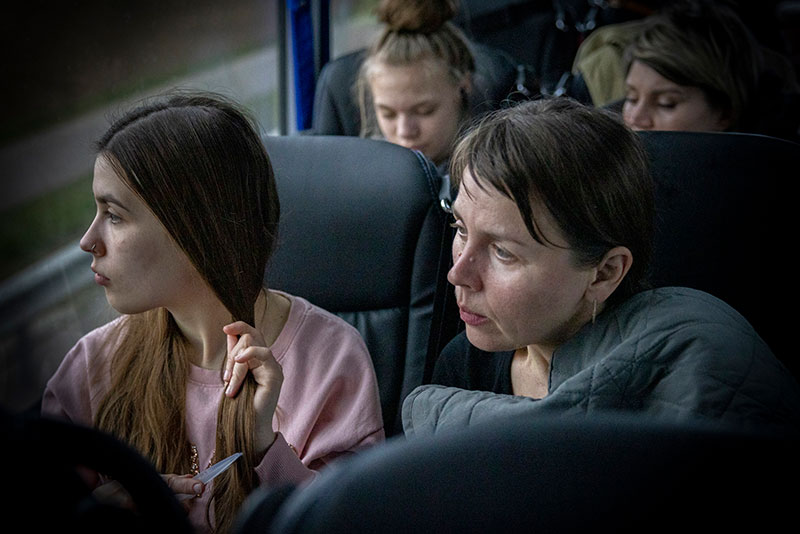The 24th of February 2023 marked the anniversary of Russia’s invasion of Ukraine. Across the UK, multiple commemorations were held at national and local level including marches, vigils, services, concerts and minutes of silence. Cambridge, where I live, like many other places across the country, ‘stood in solidarity’ with Ukraine. To date, no other war has sparked this overwhelming support at the most local level in almost every town of the UK. In stark contrast to the 2015 ‘refugee crisis’ where Europe reacted to people arriving from Syria, Afghanistan, Eritrea, Somalia and Iraq by tightening legislation and restricting rights, this time, Ukrainian refugees have been met with an overwhelming welcoming and hospitality. In the EU, for the first time since it was agreed in 2001, the Temporary Protection Directive was activated unanimously, granting Ukrainian refugees the rights to residency and work for up to three years.
Over the past twelve months, according to UNHCR figures, more than 8 million people have fled Ukraine. This means that in a country with a population of 41 million, a fifth of the population is now living in exile. The vast majority of those seeking refuge are women and many of these women are mothers fleeing with their children. Men aged 18 to 60 are required to remain in the country as they may be required to serve in the army.
In light of this on-going conflict, my new research project will examine the construction of the ‘deserving refugee mother’ in a context of solidarities. I aim to analyse how the category of the ‘refugee mother’, which has received far less attention than that of the ‘refugee child’, has been welcomed by civil society actors – both those with a long refugee support tradition and the multiple ad hoc organisations – as well as government organisations. What discourses are used by civil society, the media, and politicians to construct, shape, challenge, and negotiate the category of ‘the deserving Ukrainian mother’? How do these differ from discourses about other groups of refugee women? I aim to address these questions in my project. In this blog post, I focus on public attitudes and the reception of Ukrainian refugees in the UK particularly, and in Europe more generally.

Ukrainian woman and her daughter fleeing the war on a bus traveling from Poland to Spain. Photo ©Ana Palacios
How are Ukrainian refugees perceived by the public?
At a recent event organised by the ODI, discussion focused on how the arrival of Ukrainian refugees has impacted public and political narratives around refugees in Europe. As was noted, there is not a single European narrative on the Ukrainian conflict, but rather multiple national discourses, and then there are local experiences. At a national level, a recent study by researchers at the Migration Policy Centre compared attitudes towards Ukrainian refugees with those towards Syrian refugees in eight European countries (Dražanová and Geddes 2021). In all eight countries, respondents were strongly supportive of welcoming Ukrainian refugees: Germany and Romania were among the most positive with more than half of the respondents supportive of allowing many Ukrainian refugees into their country. Even in the countries that were more reluctant to the reception of refugees, such as Slovakia and Hungary, only ten percent of respondents said they would allow no Ukrainian refugees to enter. The analysis shows that participants in all European countries generally favour Ukrainians over Syrians, with the different attitudes to these two groups being more pronounced in Central and Eastern Europe (ibid).
However, during the 2015 ‘refugee crisis’, Syrian refugees were also perceived differently than refugees from elsewhere. They too received special treatment and were deemed more ‘deserving’ compared to other groups of refugees such as Afghans or Eritreans. In Denmark for instance, the cases of Syrian refugees were fast-tracked in the asylum system, and their family reunion policies were prioritised. In future research, it would be important to understand what drives changes in attitudes, both towards more negative and more positive attitudes.
Linking the reception of Ukrainian refugees to the Brexit discourse
For the second time in the history of immigration in the UK, the government has put in place a national immigration plan where British people were invited to open their homes to refugees. The first time was during the Second World War, at a much smaller scale, when the British government allowed Jewish children from Nazi Germany to come to the UK through what was known as the Kindertransport, where people also opened their homes. Approximately 10,000 children benefited from the scheme and it only included unaccompanied minors. However, the Kindertransport was also a temporary scheme, where the British government had more of a sanctioning role ensuring children were allowed entry on condition they would leave when they reached 18, and where many of these children were not always met with hospitality by the public, but with suspicion.
This time, the British government has put in place – within less than a month of the outbreak of the war – the Homes for Ukraine Scheme that received overwhelming public support. To date, 156,000 people have been hosted through this programme. The positive reaction to the scheme ties to the Brexit discourse where many of the Leave voters used the argument of ‘no one ever asked us’ to make a case against the arrival of refugees and migrants. This time the argument no longer holds true: on this occasion British people (and others with legal status and a roof) were asked if they wanted to not only welcome this group of refugees, but open the doors of their homes. This was done with the absence of any kind of campaign or marketing strategy. The response was that people in the UK started opening the doors to their living rooms, kitchens, dining rooms and gardens to people in need of protection. Framed by a discourse of ‘they look like us’, this group of refugees were welcomed into people’s homes. Another study linked to the Solidarities project is investigating how Ukrainian families and their hosts have experienced this scheme.
Many people who voted in favour of Brexit did so because they believed immigration, and the arrival of migrants and refugees, was one of the main problems hampering the economic growth of the country. According to a comparative study on ‘How Europeans think and feel about immigration’ the perception of immigration as one of the biggest problems in the UK has declined sharply since the Brexit referendum, with only a small minority considering it a key issue in 2021 – its lowest level in two decades. In fact, an ODI study shows that, since the referendum, public attitudes towards migrants have shifted from mostly negative to mostly positive. A 2022 study shows that for a significant amount of the British public, it is more important that migration is controlled, whether numbers are reduced or not, than that the UK pursues a policy based on deterrence that keeps the numbers low.
The other two schemes in place in the UK to receive Ukrainian refugees are the Ukraine Family Scheme which allows Ukrainians to join their families already living in the UK and the Ukraine Extension Scheme. Together the three different schemes have granted to date 223,000 visas. The Migration Observatory at the University of Oxford noted that, if we compare the situation of Ukrainian people to that of asylum-seekers, in the first six months after the war started, more people have received protection in the UK under the country’s two main Ukraine Schemes (i.e., 115,000 arrivals), than the total who received protection under the country’s asylum system and refugee resettlement routes in the six years from 2016 to 2021. Nonetheless, if we compare these numbers to the most welcoming European countries such as Poland who has granted protection to 1.5 million people or Germany that has hosted one million, or comparatively in terms of total population a smaller country like Estonia, which has welcomed 40,000 Ukrainians, amounting to 5% of its total population, this shows a less welcoming number from the UK that is hosting 223,000 – representing 2% of the Ukrainians fleeing the war.
Despite a more positive public attitude towards migrants and refugees and in this context of solidarity and a welcoming environment towards Ukrainian families, the UK’s ‘hostile environment’ for immigration was further entrenched earlier this month when the British government introduced a new Illegal Migration Bill. The Bill aims to address what the government claims as ‘illegal’ entry of immigrants to the UK via small boats known as the Channel crossings. This Bill would change the way the asylum system works, meaning that anyone arriving in the UK in small boats would no longer have the right to claim asylum and the government would have the power to remove them to a supposedly ‘safe’ third country (how safe is Rwanda?) without having to process their asylum claim. The government would also be able to detain asylum-seekers for 28 days without bail. The Home Secretary acknowledges in the document that the Bill contravenes the European Convention on Human Rights. The introduction of such a Bill polarises public opinion and makes the ‘us’ and ‘them’ and ‘deserving’ (Ukrainians) and ‘undeserving’ (asylum-seekers in small boats) refugees debate even more fractured and polarised.
Should we insist in calling them refugees?
A final important aspect to bring to the discussion is the use of the term ‘refugee’ to refer to Ukrainian people. It is important to underline that under the 1951 Refugee Convention, Ukrainians strictly fall under the definition of refugees, since they are fleeing their country due to a ‘well-founded fear of persecution for reasons of race, religion, nationality, membership of a particular social group or political opinion’. However, the UK, like several other European countries, has put in place an ad hoc scheme that give Ukrainians temporary migrant protection, but not refugee status. Under the scheme, Ukrainians are given temporary visas that allow them immediate access to the labour market, housing, and education for their children. However, unlike people who are granted refugee status, they are not eligible for family reunion. It is also important to underscore that unlike many refugees who are given indefinite stay, the visa permits given to Ukrainian families do not provide a pathway towards settlement in the UK. Therefore, despite the discourse of hospitality and solidarity from the state, the Ukrainian schemes are temporary and may prove ineffectual for those who receive protection and safe passage. If governments, both in the UK and across Europe, continue to use ‘ad hoc’ schemes for the protection of Convention refugees, then what will be the status of the Refugee Convention on the long run? Its value may be seriously undermined where the status of ‘refugee’ will be reserved to those deemed as less (non)- deserving who have no safe passages and who will potentially be deported to Rwanda, 4,000 miles from where they lodged their asylum applications.
Despite British people opening their homes to people fleeing war, nothing has changed (and it may get a lot worst) for many other people who are also seeking refuge and fleeing violence and conflict. I therefore aim to investigate how this ‘deserving’ category has been constructed and shaped by policy, media and civil society in a context that still allows other groups of refugees to be met with closed borders and human rights violations.
References
lDražanová. L and A. Geddes .2021. Attitudes towards Ukrainian refugees and governmental responses in 8 European countries in EU responses to the large-scale refugee displacement from Ukraine: an analysis on the temporary protection directive and its implications for the future EU asylum policy

